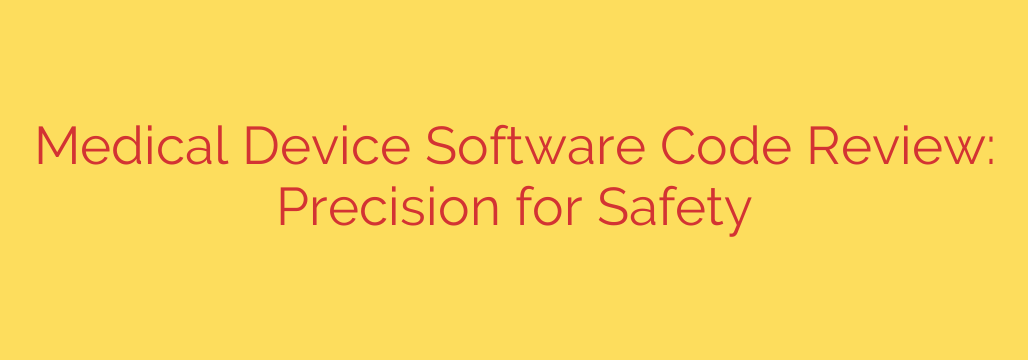
The Critical Link: How Rigorous Code Review Safeguards Medical Device Software
In the world of software development, code review is a standard practice for ensuring quality. But when that software powers a medical device, the process transforms from a best practice into a non-negotiable pillar of patient safety. The code inside a diagnostic tool, a therapeutic device, or a monitoring system has a direct impact on human health, making meticulous review an ethical and regulatory imperative.
Software as a Medical Device (SaMD) operates under a microscope of scrutiny for one simple reason: a software flaw can lead to misdiagnosis, improper treatment, or device failure, with potentially severe consequences. This is where a robust code review process becomes the first line of defense, ensuring the software is not only functional but also safe, secure, and effective.
Beyond Bug Hunting: The True Scope of Medical Code Review
While finding and fixing bugs is a crucial outcome, the purpose of code review in the medical technology space goes much deeper. It is a comprehensive examination designed to validate several critical aspects of the software.
A thorough review process is designed to:
- Verify Functional Integrity: Does the code perform its intended function precisely as specified in the design requirements? For a medical device, “close enough” is never acceptable. The review confirms that algorithms calculate dosages correctly, sensors interpret data accurately, and alerts trigger under the right conditions.
- Ensure Regulatory Compliance: Medical device software is subject to stringent standards, such as IEC 62304. Code review serves as tangible proof that development processes are being followed. Proper documentation of the review process is essential for demonstrating compliance during audits by bodies like the FDA.
- Strengthen Cybersecurity: Medical devices are increasingly connected, making them a target for malicious actors. Code review is vital for identifying and mitigating security flaws. It helps prevent vulnerabilities that could lead to unauthorized access, data breaches, or manipulation of the device’s function.
- Improve Maintainability and Longevity: Well-structured, clean, and clearly documented code is easier to maintain and update over the device’s lifecycle. A peer review process enforces coding standards that make future modifications safer and more efficient.
Pillars of an Effective Medical Software Review Process
A successful code review strategy in a regulated environment is structured, systematic, and multi-faceted. It typically relies on a combination of automated tools and human expertise to provide comprehensive coverage.
The most effective processes are built on these core pillars:
- Manual Peer Review: There is no substitute for the critical thinking of an experienced developer. A manual review by one or more peers can identify logical errors, architectural weaknesses, and non-compliance with design requirements that automated tools might miss. The context and nuance that a human reviewer brings are invaluable.
- Static Code Analysis: Automated tools that scan source code without executing it are essential for efficiency and consistency. Static analysis excels at catching common programming errors, security vulnerabilities (like buffer overflows or injection flaws), and deviations from coding standards. This allows human reviewers to focus on more complex, high-level issues.
- Comprehensive Checklists: To ensure no critical step is overlooked, teams should use detailed checklists tailored to medical device software. These checklists should cover functionality, security, compliance with standards like IEC 62304, variable naming, error handling, and documentation.
- Traceability and Documentation: Every line of code must be traceable back to a specific design requirement. The entire review process—including comments, identified issues, and resolutions—must be meticulously documented. This creates an auditable trail that is crucial for regulatory submissions and post-market surveillance.
Actionable Security Tips for Your Code Review
Integrating security into your code review is not optional. Here are key actions to take:
- Always validate input: Treat all external data as untrusted. Ensure rigorous validation is in place to prevent injection attacks or data corruption.
- Implement the principle of least privilege: Ensure the software only operates with the minimum permissions necessary to perform its function.
- Protect sensitive data: All patient data, whether in transit or at rest, must be encrypted using strong, up-to-date cryptographic standards.
- Securely handle errors: Error messages should never reveal sensitive system information that could be exploited by an attacker.
Ultimately, the quality of medical device software is a direct reflection of the rigor of its development and review processes. A culture that prioritizes meticulous code review is a culture that prioritizes patient safety. It moves beyond simply meeting requirements and embraces a profound responsibility to produce software that is trustworthy, reliable, and secure. In this high-stakes field, excellent code is not just a technical achievement—it is an ethical necessity.
Source: https://collabnix.com/code-review-in-medical-device-software-ensuring-safety-through-precision/








